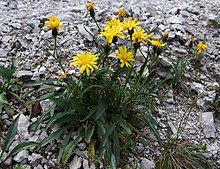Crepis
| Crepis | |
|---|---|

| |
| Crepis jacquinii | |
| Scientific classification | |
| Kingdom: | Plantae |
| Clade: | Tracheophytes |
| Clade: | Angiosperms |
| Clade: | Eudicots |
| Clade: | Asterids |
| Order: | Asterales |
| Family: | Asteraceae |
| Subfamily: | Cichorioideae |
| Tribe: | Cichorieae |
| Subtribe: | Crepidinae |
| Genus: | Crepis L. |
| Species | |
|
about 200, see text | |
Crepis, commonly known in some parts of the world as hawksbeard or hawk's-beard (but not to be confused with the related genus Hieracium with a similar common name), is a genus of annual and perennial flowering plants of the family Asteraceae superficially resembling the dandelion, the most conspicuous difference being that Crepis usually has branching scapes with multiple heads (though solitary heads can occur). The genus name Crepis derives from the Greek krepis, meaning "slipper" or "sandal", possibly in reference to the shape of the fruit.[1]
The genus is distributed throughout the Northern Hemisphere and Africa,[2] and several plants are known as introduced species practically worldwide.[1] The center of diversity is in the Mediterranean.[2]
Ecology
Crepis species are used as food plants by the larvae of some Lepidoptera species including the broad-barred white moth. The fly Tephritis formosa is known to attack the capitula of this plant.[3]
Seeds of Crepis species are an important food source for some bird species.[4]
Uses
In Crete, Greece the leaves of Crepis commutata which are called glykosyrida (γλυκοσυρίδα) are eaten raw, boiled, steamed or browned in salads. Another two species on the same island, Crepis vesicaria, called kokkinogoula (κοκκινογούλα), lekanida (λεκανίδα) or prikousa (πρικούσα) and a local variety called maryies (μαργιές) or pikrouses (πικρούσες) have both its leaves and tender shoots eaten boiled by the locals.[citation needed]
Secondary metabolites
The genus Crepis is a rich source of costus lactone-type guaianolides,[5] a class of sesquiterpene lactones.
Phenolics found in Crepis include luteolin-type flavonoids and caffeoyl quinic acid derivatives such as chlorogenic acid and 3,5-dicaffeoylquinic acid. Moreover, Crepis species contain the caffeoyl tartaric acid derivatives caffeoyl tartaric acid and cichoric acid.[6]
Diversity
There are about 200 species in the genus.[1][2]




Species include:
- Crepis acuminata – tapertip hawksbeard, longleaf hawk's-beard
- Crepis alpestris
- Crepis alpina
- Crepis aspera
- Crepis atribarba – dark hawk's-beard, slender hawk's-beard
- Crepis aurea – golden hawk's-beard
- Crepis bakeri – Baker's hawksbeard
- Crepis barbigera – bearded hawk's-beard
- Crepis biennis – rough hawksbeard
- Crepis bungei
- Crepis bursifolia – Italian hawksbit
- Crepis capillaris – smooth hawksbeard, green crepis
- Crepis conyzifolia
- Crepis dioscoridis
- Crepis foetida – stinking hawksbeard, roadside hawk's-beard
- Crepis incana – pink dandelion
- Crepis intermedia – limestone hawksbeard, small-flower hawk's-beard
- Crepis kotschyana
- Crepis micrantha
- Crepis modocensis – Modoc hawksbeard, Siskiyou hawksbeard
- Crepis mollis – northern hawksbeard
- Crepis monticola – mountain hawksbeard
- Crepis nicaeensis – French hawksbeard, Turkish hawksbeard
- Crepis occidentalis – largeflower hawksbeard, gray hawk's-beard, western hawk's-beard
- Crepis palaestina[7]
- Crepis paludosa – marsh hawksbeard
- Crepis pannonica – pasture hawksbeard
- Crepis phoenix
- Crepis pleurocarpa – nakedstem hawksbeard, naked hawk's-beard
- Crepis pontana
- Crepis praemorsa – leafless hawksbeard
- Crepis pulchra – small-flower hawk's-beard
- Crepis pygmaea – pygmy hawksbeard
- Crepis pyrenaica
- Crepis rubra – red hawksbeard, pink hawk's-beard
- Crepis runcinata – fiddleleaf hawksbeard
- Crepis sancta – holy hawksbeard
- Crepis setosa – bristly hawksbeard
- Crepis sibirica
- Crepis sodiroi
- Crepis tectorum – narrow-leaved hawksbeard
- Crepis thompsonii
- Crepis vesicaria – beaked hawksbeard, dandelion hawk's-beard, weedy hawk's-beard
- Crepis zacintha – striped hawksbeard
References
- ^ a b c Crepis. Flora of North America.
- ^ a b c Enke N., Gemeinholzer B. (2008). "Babcock revisited: New insights into generic delimitation and character evolution in Crepis L. (Compositae: Cichorieae) from ITS and matK sequence data". Taxon. 57 (3): 756–68. doi:10.1002/tax.573008.
- ^ White, I.M. (1984). Tephritid Flies (Diptera: Tephritidea). Handbooks for the Identification of British Insects. Vol. 10 pt 5a. Royal Entomological Society of London. pp. 134 pp. ISBN 0901546682.
- ^ D. L. Buckingham and W. J. Peach (2005). "The influence of livestock management on habitat quality for farmland birds". Animal Science. 81 (2): 199–203. doi:10.1079/asc50700199.[permanent dead link]
- ^ Zidorn, C. (2008). "Sesquiterpene lactones and their precursors as chemosystematic markers in the tribe Cichorieae of the Asteraceae". Phytochemistry. 69 (12): 2270–2296. doi:10.1016/j.phytochem.2008.06.013. ISSN 0031-9422. PMID 18715600.
- ^ Zidorn, C.; et al. (2008). "Phenolics as chemosystematic markers in and for the genus Crepis (Asteraceae, Cichorieae)". Scientia Pharmaceutica (Vienna, Austria). 76 (4): 743–50. doi:10.3797/scipharm.0810-25. ISSN 0036-8709.
- ^ "Crepis palaestina (Boiss.) Bornm. | Plants of the World Online | Kew Science".
